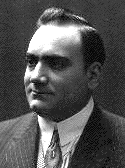WHO'S IN A NAME?
People Commemorated in Eastern Sierra Plant Names
Return to Index
Eastwood's willow, Salix eastwoodiae Cockerell ex A.A. Heller (Salicaceae)
Toothed gilia, Aliciella triodon (Eastw.) Brand [=Gilia triodon Eastw.]
~ and ~
Broad-leafed gilia, Aliciella latifolia (S. Watson) J. M. Porter [=Gilia latifolia S. Watson] (Polemoniaceae)
by Larry Blakely
References and Notes
(First Posted: 2001 12 11; Last Revised: ; Text appeared in the newsletter of the Bristlecone chapter, CNPS, September, 2001/Vol. 21, No. 5 and November, 2001/Vol. 21, No. 6)
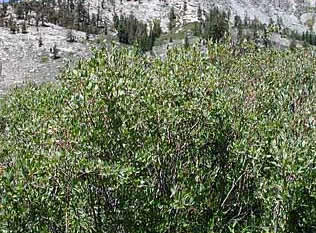
Eastwood's willow, Salix eastwoodiae Cockerell ex A.A. Heller
Photo and © by Larry Blakely
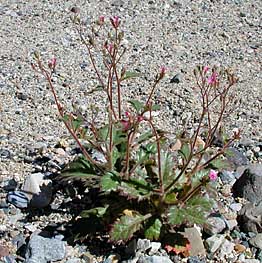
Broad-leafed gilia, Aliciella latifolia (S. Watson) J. M. Porter
Photo and © by Larry Blakely
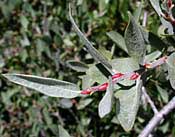
Eastwood's willow occurs in moist areas at high elevations in the Sierra Nevada. This especially attractive shrub, bearing woolly stems and leaves, and with lots of red in its stems and buds, may be found growing abundantly in Onion Valley. It was named in honor of Alice Eastwood (1859-1953), long associated with the California Academy of Sciences (CAS) in San Francisco, by a contemporary of hers, the highly regarded bee specialist T. D. A. Cockerell (of the University of Colorado). The name was published within a larger 1910 publication by the California-Nevada botanist A. A. Heller. Salix eastwoodiae is one of 8 California plant species named for Eastwood which contain 'eastwood' in the specific, subspecific, or varietal names; Erigeron aliceae, another California plant named for her, invokes her given name. Only the willow occurs in the Eastern Sierra.(1), (1a), (2), (3).

Alice Eastwood ca. 1910. CAS, used by permission.
Click on the picture for a SLIDE SHOW of more Eastwood images. Additional portraits may be found on a CAS website.
In 1892, while botanizing in Utah and Colorado (the latter being the state in which she came to maturity as a botanist), Eastwood discovered a new Gilia which she named G. triodon in an 1893 publication. (This plant also occurs in eastern California; Mary DeDecker made 11 collections of it in Inyo Co., over the years 1969 - 1995.) All of us who have struggled to identify Gilias would readily agree that it is a difficult and diverse group. Members of several current genera, such as Linanthus and Loeseliastrum, were, in Asa Gray's time, included within Gilia. Many botanists over the years have made attempts to sort out the variability and come up with better groupings of this disparate melange of species. In 1905, the year before the disastrous San Francisco earthquake - so fateful for Eastwood, the German botanist August Brand came to believe that Eastwood's plant was sufficiently different to warrant a new genus, which he named Aliciella in recognition of her as the discoverer, and also out of gratitude for Eastwood's help with specimens. People aren't usually honored with plant names based on their given name, but there already was a genus Eastwoodia, with one species, for a shrub of the sunflower family (Eastwoodia elegans Brandegee) which Eastwood discovered in central California. It was named for her in 1904, 10 years after Eastwood became Curator of Botany at the CAS, by her mentor and predecessor, Katherine Brandegee. (4), (5), (6).
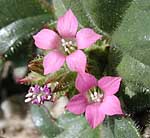
Brand's genus Aliciella was not widely accepted and was relegated to footnote status throughout most of the 20th century. In a recent attempt to straighten out the Phlox family problem children, based on DNA analyses, J. Mark Porter, Rancho Santa Ana botanist, has revived the genus name and placed many former members of Gilia in it. Broad-leafed gilia (or holly gilia as Mary called it) is one of several of the new Aliciellas that occur in our region - and one of the most striking. It is always a pleasure to encounter along arid Eastern Sierra washes with its large glossy dark green leaves, forming a beautiful background for its bright dark pink flowers. It was first collected in 1874 by C. C. Parry in the vicinity of the Virgin River in Utah. Parry sent his collection to Harvard, where it was named by Asa Gray's brilliant but somber protege Sereno Watson. Now, entering the revived genus, it takes on an association with the renowned 'Miss Eastwood' (as she was known to her multitudinous and far flung associates). (4), (7), (8).
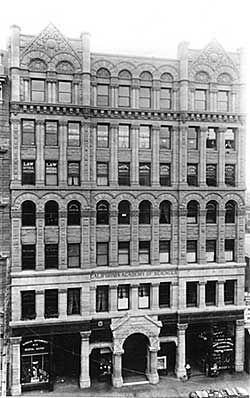
The California Academy of Sciences building in San Francisco, ca. 1895 (CAS, used with permission)
Eastwood was largely self educated, with no formal schooling beyond high school in Colorado. College degrees weren't necessary for this brilliant and energetic self starter. She developed a consuming interest in botany early in life, which carried her through an outstanding career. She was Curator of Botany at the CAS for over half a century, retiring in 1949 at age 90. In the course of those years she nurtured numerous budding botanists and horticulturists, saved precious museum specimens and records during a heroic day in 1906, built up a vast plant collection - twice - before, and again after, the big quake. She became deeply engaged in all matters pertaining to botany - from the most basic levels of taxonomy to the most practical aspects of horticulture. And, she once wrote to a friend, " . . I love all those who love plants.". (9) She travelled much of California on foot, horseback, stage coach, and later, automobile in her quest for new specimens for the Academy, and new species for science (she named 125 species of California plants). While many contemporaries (e.g., Jepson, McMinn) gave floral and other measurements in inches and feet [and even the archaic "line" (1/12 inch)], Eastwood used the metric system in her publications. She published more than 300 scientific papers, articles of more general interest, and books. (10)
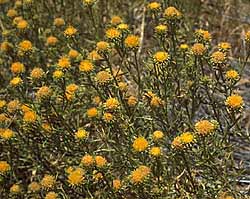
Eastwoodia elegans
(photo by J. E.(Jed) and Bonnie McClellan, CAS, from the CalFlora website.)
She was by all accounts a woman of robust stature and ample voice, "endowed with unusual energy", "she could endure the hardships of arduous field work", and it was said that she could sustain travel at 4 mph on foot, easily covering 20 miles a day in the field (40 on a horse). Early on she was discouraged from going on excursions with an all-male hiking club, but the men later gave her full welcome when it was found that she could keep up with the best of them.
No doubt stemming from the poverty experienced during her youth, she was always of a frugal nature. It appears that, through the first decade or two of the 20th century, her monthly income was in the $55 - $75 range. A minor real estate investment (a vacant lot in young Denver) brought her a handsome return when she sold it during a boom period. She invested the proceeds prudently, which brought her a measure of financial independence, but only because of her frugality. She often returned to the Academy near penniless after a lengthy field trip.
On the evening of April 17, 1906, Enrico Caruso thrilled the San Francisco Mission Opera House audience with another stunning performance as Don José in Bizet's Carmen. Eastwood, a lover of opera and other musical art forms, just might have been in attendance. The city finally slept after all its varied forms of night life had ended. The disaster struck in the morning. Buildings shuddered, collapsed, and soon the fires began. Alice hurried to the Academy building, frantically searching for a way in. Finally, she and a few others gained access to the interior. Alice and a friend climbed the spiral staircase (by climbing up the metal railing, as most of the stone steps were in a heap on the ground floor) to the herbarium on the 6th floor. They gathered up the very most important specimens, and escaped as flames roared in from neighboring buildings. She then searched desperately for someone with a cart to help her move her bundles of scientific treasure - she had charge of all that would be saved of the museum - as the city was being absolutely destroyed around her. Jack London, eyewitness to the quake's immediate aftermath, described the awful scene of which Eastwood was a part: "All the shrewd contrivances and safeguards of man had been thrown out of gear by thirty seconds' twitching of the earth-crust. . . . The hills of San Francisco are steep, and up these hills, mile after mile, were the trunks dragged. . . .". Alice wrote, "The sound of the trunks being dragged along I can never forget. This seemed the only groan the ruined city made." As for the horror elicited by the quake itself, Caruso wrote "I . . . go to the window, raise the shade and look out. And what I see makes me tremble with fear. I see the buildings toppling over, big pieces of masonry falling, and from the street below I hear the cries and screams of men and women and children." In her daring venture, Eastwood saved 1497 of the most important plant specimens including 1211 irreplaceable type specimens. All else was lost - the largest botanical collection in the western US. But amid the horror of human suffering and death, an important bit of human heritage had been rescued for the future. (11)
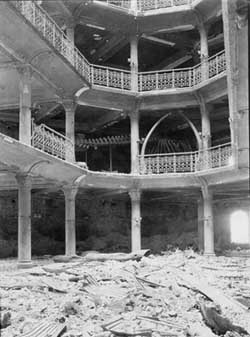
Shell of the California Academy of Sciences building after the 1906 earthquake
(CAS, used with permission)
Eastwood apparently collected little in the Eastern Sierra (she is listed as a collector of 48 specimens from Alpine and Mono Cos., and 3 from Inyo Co., in the CalFlora Occurrence Database), but her protege, and later successor, John Thomas Howell spent much time here (he is listed as collector of 1165 specimens for Inyo Co., in the same database). Mary DeDecker's specimen cards contain frequent notation of his findings in the area. I don't know if Mary ever met Alice, but Howell was well known to Mary and was an important mentor to her. Early in her studies of the Eastern Sierra flora, Mary was advised to send her specimens to the CAS (and also to the Rancho Santa Ana Botanic Garden) for any help she might need with identification. (12)
Eastwood was a broad-minded and caring person who promoted women's interests and initiated important conservation projects. She was a great promoter of the love of plants, the outdoors, and the preservation of natural resources. In an obituary in 1953, Tom Howell wrote, "The honor she most deeply appreciated was the naming of the beautiful recreation area on Mount Tamalpais, Camp Alice Eastwood, by the California Division of Beaches and Parks and the Tamalpais Conservation Club, of which she had been a founder and was a past president." (13)
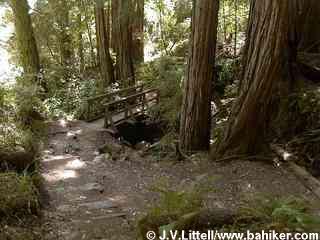
A Mt. Tamalpais trail
(Bay Area Hiker, used with permission.)
She did not care much for convention, either in dress or social habits, but was nevertheless a master of social skills. At age 94 she wrote, "I count my age by friends, and I am rich in friends." (14) A free-thinker in matters of religion and philosophy, she disdained dogmas. She wrote, "To me the feeling that comes from the order and law of the universe is truly religious and I think that every scientific person must be religious without any belief in a dogma of any kind." (15)
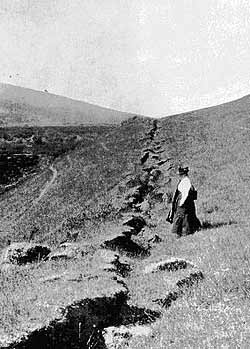
Geologist G. K. Gilbert and Alice Eastwood inspected a fault trace resulting from the 1906 earthquake, on Pt. Reyes peninsula. Photo, by Gilbert, shows Alice by the fault. (19)
She never married, but twice in her life she was prepared, apparently, to give up botany for marriage; both times death of her suitor prevented it. One was the eminent geologist Grove Karl Gilbert. It appears that, among men who found her attractive, one was none other than Willis Jepson, another great California botanist of the first part of the 20th century. According to Eastwood's private correspondence, he visited her in 1893 in the CAS herbarium "faultlessly attired", "acted in an embarrassed way", and "was scared out of his wits"; "I was most agreeable", wrote Eastwood. (16) As it turned out, Jepson never married either. (17)
Alice Eastwood's accolades were numerous.
In 1903 she was one of only two of the few women listed in American Men of Science to be denoted, by a star, as being considered to be among the top 25% of professionals in their discipline. Her entry bore a star throughout all subsequent editions during her life. (18)
C. S. Sargent, Director of the Arnold Arboretum at Harvard University, wrote, in 1923 letters to Eastwood, " . . . [you are] the only really efficient botanist in California." and " . . . [you are] the only reliable person in California and I feel much more confident of obtaining anything botanical from you than I do . . . from anyone else." (20)
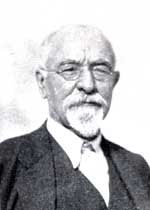
Marcus Jones in 1931 (21)
Marcus Jones, the nettlesome but well regarded and highly productive Western botanist, delighted readers of his self-published (and self printed!) works with caustic snippets about his contemporaries in a series he called "Botanists I Have Known". In one of his short sketches he even tore to shreds the near saintly image of C. C. Parry. But for Alice Eastwood, he had only praise. In 1933 he wrote, "Her work, like mine, is mostly done and the falling leaves will soon obscure our graves, but it will be many a day before botanists will cease to venerate her magnificent work for the Academy. I have known her for a generation, and we have worked over the same field, but I have found her too big for jealousies and petty squabbles, which have disgraced a certain envious critic" [an apparent jab at Jepson]. Alice remained active for nearly two more decades, but Jones died in the following year, at age 82, in an accident while driving to his home in Claremont after a day's collecting trip to the San Bernardino Mtns.(21)
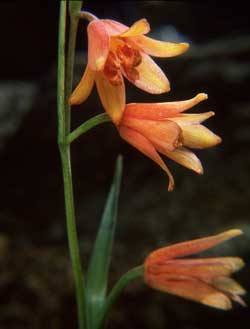
Fritillaria eastwoodiae; Butte County Missionbells
(photo by Gladys Lucille Smith, CAS, from the CalFlora website.)
In a volume honoring her 50 years service as Curator of Botany at the CAS, an event celebrated in 1942, F. M. MacFarland, past president of the Academy, wrote, at the conclusion of his tribute: "Her frank, direct approach to every problem and her modest, kindly spirit have won for her the esteem and love of countless loyal and devoted friends who wish for her many more years of productive activity in the field she loves." (10) Another wrote, "There has never been anyone like her on earth and there never will be, if I am permitted to prophesy." (22) In 1950 the outstanding historian of botany and natural history in general, Joseph Ewan, wrote: "indubitably the best known woman botanist in this country today". (23) Her greatest tribute came in 1950 when she was made a president of the VIIth International Botanical Congress, held in Sweden, where she was proud to preside from a study chair used by Linnaeus. She died three years later at age 95.
In a 1906 letter to Science magazine, reporting on the devastating effects of the earthquake, Eastwood wrote: "My own destroyed work I do not lament, for it was a joy to me while I did it, and I can still have the same joy in starting it again." (24) But she did more than start again. Already, in 1942, the number of plant specimens in the CAS herbarium had grown to over 300,000, nearly three times the number lost in 1906, a result of the untiring efforts of the indefatigable Miss Eastwood.
REFERENCES and NOTES
1. Some Eastwood biographies
- Dakin, Susanna Bryant. 1954. The Perennial Adventure; A Tribute to Alice Eastwood. Cal. Acad. Sci.
- Wilson, Carol Green. 1955. Alice Eastwood's Wonderland; the Adventures of A Botanist. Cal. Acad. Sci.
- Bonta, Marcia Myers. 1991. Women in the Field; America's Pioneering Women Naturalists. Texas A & M Univ. Press. Includes bios of Kate Brandegee and Alice Eastwood.
- Moore, Patricia Ann. 1996. Cultivating Science in the Field: Alice Eastwood, Ynés Mexia and California Botany, 1890-1940. PhD Dissertation, UCLA; UMI 9640244.
- Ross, Michael E. and Caple, Laurie A. 1997. Flower Watching with Alice Eastwood. Carolrhoda Books, Inc. Minneapolis. 48 pp. A "Naturalist's Apprentice Series" book; a charming young person's book with many photos of Eastwood.
1a. Thanks to Librarian Bea Beck for much help with Eastwood materials at the Rancho Santa Ana Botanic Gardens.
2. Heller, A. A. 1910. Cat. N. Am. Pl. ed. 2, 89. Referenced in Abrams, L., 1940. vol. I, p. 499, Illus. Fora of the Pacific States, Stanford.
3. The number of plants named for or by Eastwood was determined by a search of the CalFlora Database.
4. Porter, J. Mark. 1998. Aliciella, a Recircumscribed Genus of Polemoniaceae. Aliso, 17:23-46.
5. Eastwood wrote, "Gray was terribly mixed on some of the [Gilia] species . . .", Moore (1), p 77.
6. Brand, A. 1905. Aliciella, eine neue Gattung der Polemoniaceen. Helios, 22:77.
7. Porter, J. Mark, and Johnson, Leigh A. 2000. A Phylogenetic Classification of Polemoniaceae. Aliso, 19:55-91.
8. Cronquist, A., et al. 1984. Intermountain Flora, vol. 4. NY Botanical Garden. (Collection history, p. 112.)
9. Moore (1), p 97.
10. MacFarland, F. M., et al. 1943-1949. Biographical Sketch of Alice Eastwood, and, Bibliography of the Writings of Alice Eastwood. Proc. Calif. Acad. Sci. Fourth Series, Vol. XXV, pp.IX-XIV and XV-XXIV respectively.
11. Caruso's and London's reactions to the earthquake may be found at the Museum of the City of San Francisco website:
Enrico Caruso and the 1906 Earthquake
Jack London and the Great Earthquake and Fire
12. A tribute to Mary and Paul DeDecker, in the Inyo Register, Sunday, June 30, 1996, mentions Mark Kerr's encouragement of Mary's interest in botany, and his recommendation that she send specimens to the CAS and RSABG.
13. Howell, John Thomas. 1954. Alice Eastwood, 1859-1953. Sierra Club Bulletin, 39(6):78-80.
14. Dakin (1), p. 18.
15. Bonta (1), p. 102.
16. Moore (1), p. 39.
17. Beidleman, Richard G. 2000. Willis Linn Jepson - "The Botany Man". Madroño 47(4):273-286.
18. Her bio in the 1910 edition (Cattell, J. M. 1910. American Men of Science. NY The Science Press.) reads:
Eastwood, Miss Alice, 1221 Lombard St, San Francisco, Cal. *Botany. Toronto, Can, Jan. 19, 59. High sch. Teacher, high sch, East Denver, 80-90; curator, bot. dept, Cal. Acad. Sciences, 92- F.A.A; Cal. Acad. Systematic botany; phanerogams.
19. Lawson, Andrew C. 1908. The California Earthquake of April 18, 1906. Report of the State Earthquake Investigation Commission, Carnegie Institution of Washington, Pub. no. 87, vol. I, pp. 451. Reprinted 1969. [The photo is plate 40A, used by permission of the Carnegie Institute.]
20. Moore (1), p 93.
21. Jones, Marcus E. 1933-1935. Contributions to Western Botany, No. 18. Claremont, California.
22. Bonta (1), p 102.
23. Ewan, Joseph Andorfer. 1950. Rocky Mountain Naturalists. Univ. of Denver Press. p. 200.
24. Eastwood, Alice. 1906. Science, May 25, p. 825.
